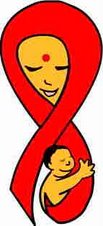Patna Feb 13, 2007
Ashok Mishra- Hindustan Times
The word HIV/AIDS may be dreaded the world over, but in Bihar’s rural hinterland nearly 35 per cent married men and 70 per cent women have no idea about it. In urban areas, there are nine per cent men, who have never heard of it.
These are the findings of the latest National Family Health Survey (NHFS), which shows with devastating clarity the extent to which Bihar has failed to create a properly functional public health system. The fieldwork for the survey of 2005-2006 was conducted between April and July 2006.
The NHFS is a massive all-India survey which gives key indicators on vaccination rates, HIV/AIDS rates, child nutrition, infant mortality etc. The last one was conducted in 1999.
In the last six years, the number of children, who are wasted (too thin for height) in Bihar, has gone up to 28 per cent in 2005-06 from 20 per cent recorded in 1999 while the number of underweight children (too thin for age) has reached 58 per cent from 54 per cent in 1999.
Though the trends in infant mortality in rural areas is encouraging as the rate has gone down from 68 per cent to 63 per cent, it has surprisingly risen to 54 per cent from 53 per cent in urban areas during the last survey.
The total fertility rate is 4 children per woman, mocking at the much-publicized two-child norm. Nearly 60.3 per cent of the surveyed women were married at 18 and 25 per cent women in the age group of 15-19 had become mothers, or were pregnant. Craving for sons refuses to die down as 77.4 per cent married women with two living children wanted sons.
Only 34.1 per cent women aged between 15 and 49 years use family planning. Just 28.8 per cent of these women used modern methods, compared to male counterparts, of whom just 23.8 percent have tried it.
Overall 82.4 per cent children aged 12 to 23 months were immunised while only 22.2 per cent children with diarrhoea were given ORS. Just 48.7 per cent of the children were taken to a health facility while just 54.6 per cent of kids with complaints of acute respiratory infections had access to any health facility.
Despite spread of awareness at every level only 4 per cent received breast-feeding within an hour of birth. No wonder 58.4 per cent of children below three years were found underweight; 42.3 per cent of them are stunted and 27.7 percent are wasted, according to the survey.
The survey found that 43 per cent of women had less than normal body mass index. The percentage for men being significantly lower at 28.7. The percentage of anaemic children between 6 and 35 months is 87.6, while 68.3 per cent married women were anaemic, the report added.
As much as 46.3 per cent newly married women participate in household decisions, while 59 per cent ever-married women experienced spouse violence, the survey said.
